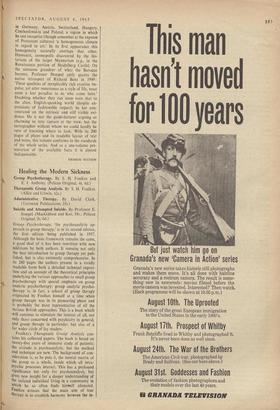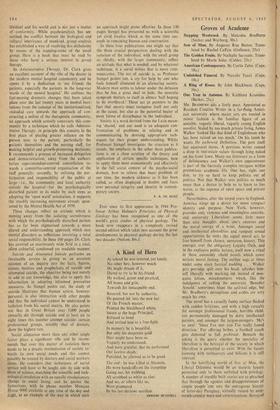Healing the Modern Sickness
Group Psychotherapy. By S. H. Foulkes and E. J. Anthony. (Pelican Original, 4s. 6d.) Therapeutic Group Analysis. By S. H. Foulkes.
(Allen and Unwin, 42s.)
Group Psychotherapy, 'the psychoanalytic ap- proach to group therapy,' is in its second edition,
the first edition being published in 1957.
Although the basic framework remains the same, a good deal of it has been rewritten with new additions by both authors. It remains not only the best introduction to group therapy yet pub- lished, but is also extremely comprehensive. In its 280 pages the authors present in a vividly readable form both a detailed technical exposi- tion and an account of the theoretical principles underlying the various approaches to small group Psychotherapy with special emphasis on group analytic psychotherapy; group analytic psycho- therapy is, in fact, a school of group therapy originated by Foulkes himself at a time when group therapy was in its pioneering phase and is probably the most •representative of all the various British approaches. This is a book which will continue to stimulate the interest of all, not only those concerned with psychiatry in general, and group therapy in particular, but also of a far wider circle of lay readers.
Foulkes's Therapeutic Group Analysis con- tains his collected papers. The book is based on
twenty-five years of intensive study of patients; the attitude is psychoanalytic, but the method and technique are new. The background of con- sideration is, as he puts it, the mental matrix of
the group as a whole, inside which all intra- Psychic processes interact. This has a profound significance not only for psychoanalysis, but gives new insight for a deeper understanding of the isolated individual living in a community in which he so often finds himself alienated. Foulkes stresses that the main aim of true therapy is to establish harmony between the in-
dividual and his world and is nbt just a matter of conformity. While psychoanalysis has un- earthed the conflict between the biological and cultural inheritance of mankind, group analysis has established a way of resolving this dichotomy by means of the stepping-stone of the small group. Here is a book that must be read by those who have a serious interest in group therapy. In Administrative Therapy, Dr. Clark gives an excellent account of the role of the doctor in the modern mental hospital community and he opens it by a dedication to 'my friends the patients, especially the patients in the long-stay wards of the mental hospital.' He outlines the fast-moving dramatic changes that have taken place over the last twenty years in mental insti- tutions from the concept of the institutionalised, custodial care towards the approach of con- structing a milieu of the therapeutic community, an approach which actively constructs this com- munity by a technique which he calls Adminis- trative Therapy; in principle this consists in the first place of placing greater reliance on the person next to the patient, particularly the patients themselves and the nursing staff, for making helpful and growth-promoting decisions; It recommends a process of increased delegation and democratisation, away from the authori- tarian superintendent-centred constellation to- wards a committee-centred organisation of the staff generally; secondly, by enlisting the par- ticipation and responsibility of the public at large—i.e., the community and local authority outside the hospital—for the psychologically disturbed patient in its midst by such steps as adopting the 'open ward' orientation, it supports the steadily increasing movement already spon- sored by the Mental Health Act of 1959.
These changes reflect an attitude which is moving away from the isolating secretiveness with which the psychologically disturbed patient has so far been stigmatised towards a more shared and understanding approach which sees mental disorders as reflections involving a total social responsibility. In these 160 pages Dr. Clark has covered an enormously wide field in a vital, often colourful, condensed yet readable manner.
Suicide and Attempted Suicide performs an invaluable service in giving us an accurate account of an inquiry into the facts, figures, causes, motives and prophylaxis of suicide and attempted suicide, the objective being not merely to add to our knowledge, but also to apply this information in adopting informed preventive measures. As Stengel points out, the study of suicide illustrates that human action, however personal, is also interaction with other people and that the individual cannot be understood in isolation from his social matrix. He also points out that in Great Britain over 5,000 people annually die through suicide and at least six to eight times this number attempt suicide; certain professional groups, notably that of doctors, show the highest rate.
Social alienation more than any other single factor plays a significant role and he recom- mends that over this matter of isolation there needs to be a drastic reorientation of society to- wards its own social needs and this cannot possibly be treated by doctors and social workers alone. He considers that techniques of social service will have to be taught side by side with those of science, matching the scientific and tech- nological revolution with an equally revolutionary change in social living, and he quotes the Samaritans, with its phone number Mansion House 9000 available at any time of the day and night, as an example of the way in which such an approach might prove effective. In these 130 pages Stengel has presented us with a scientific yet vivid treatise which at the same time suc- ceeds in remaining human and constructive.
In these four publications one might say that the three crucial perspectives dealing with the isolation of the individual, with the small group or, thirdly, with the larger community; reflect an attitude that what is needed, and by whatever technique, is a social milieu that is more com- municative. The act of suicide is, as Professor Stengel points out, a cry for help by one who feels himself alienated in' an alienating society. Modern man seems to labour under the delusion that he has a great deal to hide, the neurotic symptom mutters to itself in silence 'half hoping to be overheard.' These act as pointers to the fact that society must recognise itself not only as the cause, but also as the potential healer of most forms of disturbance in the individual.
Society is a word derived from the Latin mean- ing 'shared,' and our need is an adequate con- frontation of problems in relating and in communicating by devising appropriate tech- niques for their proper understanding. Whilst Professor Stengel investigates the situation as it stands, the emphasis in the other three publica- tions is on a close scrutiny of the theory and application of certain specific techniques, how to apply them most economically and effectively in the full social context of the psycho-social domain, how to relieve that basic problem of our time, the modern sickness as it has been called, so often displayed in doubts and fears over .personal integrity and identity in contem- porary society.
P. B. DC MARE
Ever since its first appearance in 1944 Pro- fessor Arthur Holmes's Principles of Physical Geology has been recognised as one of the world's great studies of physical geology. The book now reappears in a completely revised second edition which 'takes into account the great developments in physical geology during the last two'clecades (Nelson, 844































 Previous page
Previous page